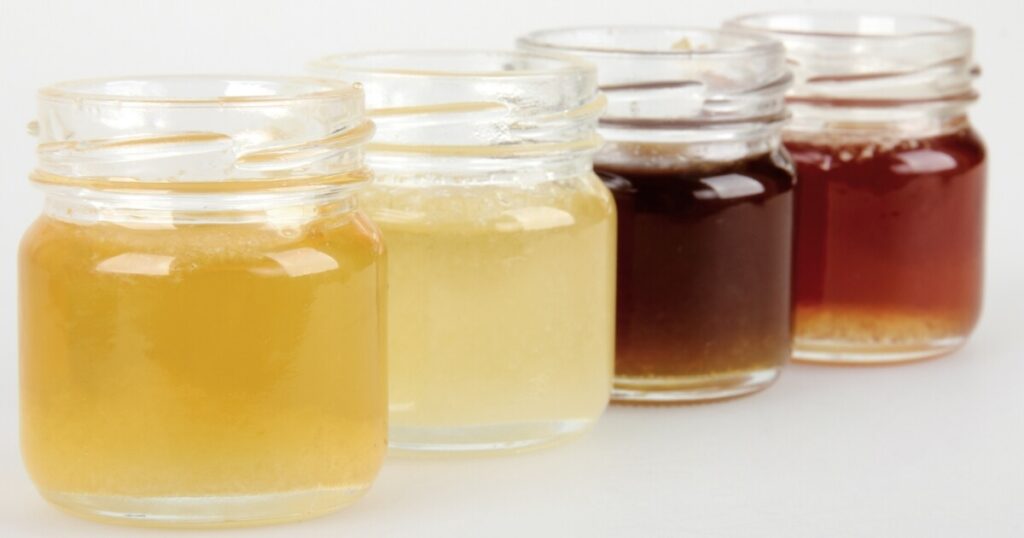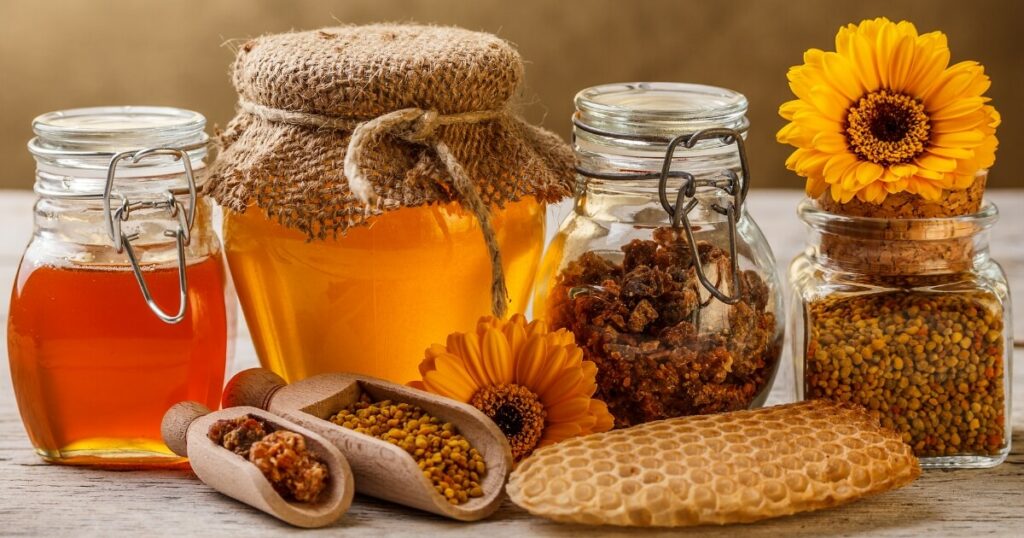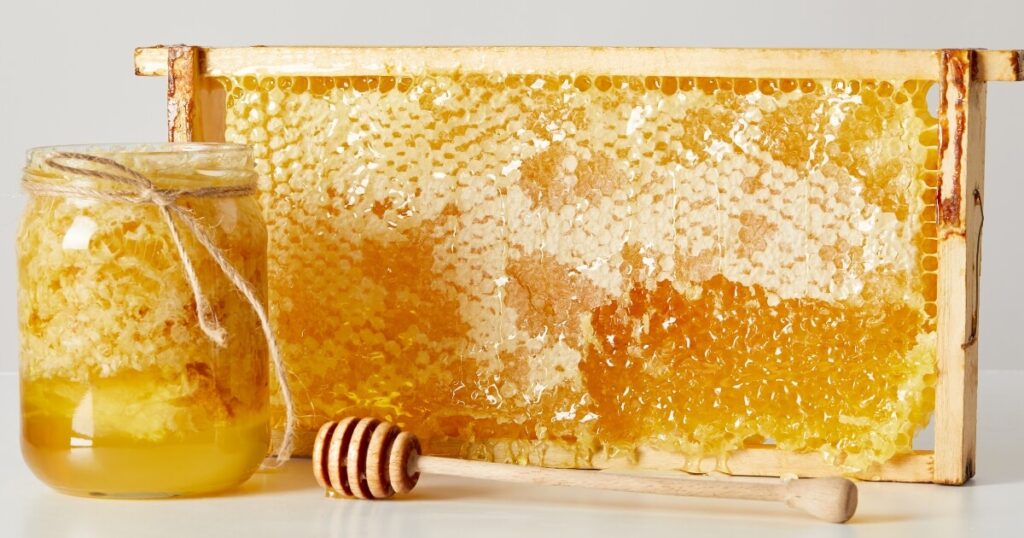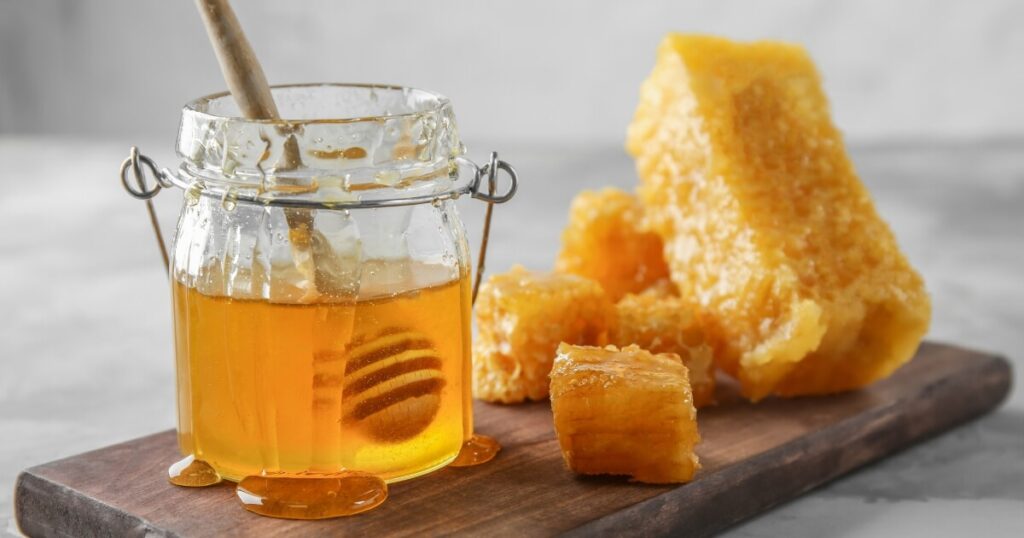Honey, that golden, viscous, sweet substance, tastes as complex as its journey from flower to jar. Have you ever wondered why honey tastes the way it does?
Honey’s taste is floral, fruity, smoky, woody, spicy, nutty, and even earthy. It can be as fresh as grass or as intense as aged cheese. Picture a spoonful of honey melting on your tongue, releasing these myriad flavors in a slow, delicious cascade.
In this guide, we will unravel the mystery of honey’s taste by explaining why it tastes the way it does, how its taste can vary, and what influences its unique flavor profile.
Types of Honey And Their Tastes

Honey comes in various flavors, each unique and influenced by the nectar source that the bees have collected from. Here are a few types of honey and their distinct tastes:
Amber/Orange Honey: This type of honey is known for its jammy fruit flavors. It brings to mind the taste of ripe peaches, apricots, and mangoes. Its sweetness is deep, ending with a slightly metallic note. It’s a honey that lingers on your palate, making it perfect for pairing with robust cheeses or drizzling over warm, buttered toast.
Buckwheat Honey: Buckwheat honey is a dark, full-bodied honey that’s rich in antioxidants. Its taste can be earthy and robust, with a hint of maltiness. Some people even describe it as having a slight ‘gamey’ flavor. It’s a honey that stands up well in hearty dishes, making it a great addition to a barbecue marinade or a glaze for roasted vegetables.
Manuka Honey: Originating from New Zealand, Bees make Manuka honey from the nectar of the tea tree bush. It’s known for its flavor and medicinal properties. It’s more complex than your average honey, with a floral sweetness that’s balanced by a slight bitterness and a salty finish. It’s a honey that’s as good on a slice of toast as it is in a cup of tea.
Clover Honey: Clover honey can be in most regions and one of the more popular types of honey. It has a pleasingly mild and sweet flavor with a touch of floral undertones. The aftertaste is light and clean, making it a versatile honey that can be used in many dishes, from sweet to savory.
These flavors can be subtle or bold, simple or complex, but they all contribute to the delightful experience that is tasting honey.
Does Honey Taste Good?
The taste of honey is generally well-loved for its sweet and complex flavor profile. However, whether honey tastes good can be subjective and largely depends on individual preferences.
Some people might find certain types of honey too sweet for their liking. The strong, distinctive flavors of darker kinds of honey like buckwheat or Manuka might put others off.

These types of honey have a robust flavor that can be quite different from the mild sweetness of more common honey like clover or orange blossom.
A common misconception about honey is that if it crystallizes, it’s spoiled or no longer good to eat. This is not true.
Crystallization is a natural process that occurs when the sugars in honey solidify. Some people actually prefer their honey in this state, enjoying the grainy texture as a spread on toast or a sweetener in hot drinks.
As for fresh versus frozen, honey is one of the few foods that doesn’t spoil. It doesn’t need to be frozen to extend its shelf life. In fact, freezing honey can change its texture and make it harder to use. Honey is best stored at room temperature, away from direct sunlight.
How to Make Honey Taste Better
While honey is naturally delicious, there are ways to enhance its flavor and make it even more enjoyable. Here are a few tips:
Pair it with complementary flavors: Honey pairs wonderfully with a variety of foods. Try drizzling it over yogurt or oatmeal, adding it to a cheese platter, or using it to sweeten a cup of tea. The flavors of these foods can bring out the unique notes in the honey and make it taste even better.
Use it in cooking: Honey is a delicious addition to both sweet and savory dishes. It can add a touch of sweetness to a marinade for meat, or it can be used in baking to add moisture and flavor to cakes and cookies.
Choose the right type for the occasion: Different types of honey have different flavors. For instance, robust buckwheat honey might be too overpowering for a delicate dish, while mild clover honey might not stand up to strong flavors. Choosing the right type of honey for your dish can enhance both the taste of the honey and the taste of the food.
Store it properly: Honey can absorb flavors from its surroundings, so storing it in a tightly sealed container is important. Keeping it at room temperature will also preserve its texture and flavor.
Remember, the best way to enjoy honey is to savor it in a way that suits your taste. Whether you prefer it straight from the spoon or as a sweet addition to your favorite dishes, honey is a versatile ingredient that can taste even better with a little thought and creativity.
Raw Honey vs. Processed Honey
When it comes to honey, one key factor influencing its taste is whether it’s raw or processed.

Raw honey is honey extracted from the honeycomb and strained to remove any debris like beeswax or dead bees. It’s not heated or pasteurized, which means it retains all of its natural vitamins, enzymes, and other nutritional elements.
The taste of raw honey can vary greatly depending on the flowers the bees have visited. It can be floral, fruity, smoky, woody, spicy, nutty, or earthy. The texture can also vary, with some raw honey being smooth and others being more granular, especially if it has started to crystallize.
Processed honey undergoes a heating and filtration process. This process gives it a more uniform color and texture and also extends its shelf life.
However, the heating process can also degrade some of the honey’s natural flavors and nutrients. As a result, processed honey often has a simpler, sweeter taste compared to raw honey.
It’s also smoother and more liquid, which some people might prefer, especially for drizzling over food or adding to drinks.
In the end, whether raw or processed honey tastes better to you might depend on what you’re looking for. You might prefer raw honey if you value complex flavors and nutritional benefits. If you prefer a smoother texture and a simpler, sweeter taste, processed honey might be more to your liking.
The Difference Between Real Honey vs. Fake Honey
Distinguishing real honey from fake honey can be a bit tricky, especially when it comes to taste.
Real honey has a complex flavor profile that can include notes of flowers, fruits, and spices, depending on the nectar source. It’s sweet, but the sweetness is rich and nuanced, not just plain sugary.
Fake honey, however, often tastes overly sweet with a simple, one-note flavor. It lacks the depth and complexity of real honey. Fake honey may have a mild, honey-like taste, but it’s usually not as rich or flavorful as real.
Another clue can be the aftertaste. Real honey has a pleasant aftertaste that lingers on your palate, while fake honey often leaves a metallic or chemical aftertaste.
Remember, buying from a reputable source is the best way to ensure you’re getting real honey. If the price is way too good to be true, it probably is.
What Does Honey Look Like?
Honey’s appearance can vary greatly depending on its type and quality. In general, honey is a thick, viscous liquid that can range in color from a pale, almost translucent yellow to a deep, rich amber or even dark brown.

Raw honey, especially, can have a cloudy or creamy appearance due to the presence of pollen, beeswax, and other natural elements. It may also crystallize over time, which gives it a solid, grainy texture. This natural process doesn’t mean the honey has gone bad.
Conversely, processed honey is usually clear and smooth, with a uniform color and consistency. It’s less likely to crystallize, so it stays liquid and clear for longer.
When buying honey at the grocery store, look for a well-sealed jar with a clean, attractive appearance. The honey should be clearly labeled with its type and source and contain no additives or artificial ingredients.
If possible, choose honey that’s been locally produced, as this is often fresher and of higher quality.
Sweeteners That Taste Similar To Honey
While honey has a unique flavor profile, a few other sweeteners can offer a similar taste experience. Here’s how they compare:
- Maple Syrup: This natural sweetener has a rich, caramel-like flavor that can sometimes resemble the sweetness of honey. However, it also has a unique woodsy note that’s distinctively “maple.” It’s less viscous than honey and has a darker color.
- Agave Nectar: This sweetener made from the agave plant. It’s sweeter than honey but has a similar viscosity and mild, neutral flavor. It’s a good vegan alternative to honey.
- Molasses: Molasses is actually a byproduct of sugar production. It’s thicker and darker than honey, with a robust, slightly bitter flavor. While it doesn’t taste exactly like honey, it can bring a similar depth of flavor to baked goods.
- Date Syrup: Made from dates, this sweetener has a rich, fruity flavor that can be similar to some types of honey. It’s less sweet than honey but brings a unique flavor that can complement many dishes.
Each of these sweeteners has its own unique characteristics, but they can all bring a touch of sweetness that’s reminiscent of honey.
They can be used as substitutes in recipes, but keep in mind that the flavor and sweetness might not be exactly the same.
Recipes And Side Dishes With Honey
Here are some popular recipes and side dishes where honey plays a starring role:
- Honey Glazed Carrots: This simple side dish brings out the natural sweetness of carrots. Just toss some baby carrots in a mixture of honey, butter, salt, and pepper, then roast until tender and caramelized.
- Honey Garlic Chicken: This is a popular dish where chicken is marinated in a mixture of honey, garlic, soy sauce, and a touch of vinegar, then baked or pan-fried. The honey gives the chicken an incredibly delicious sweet, sticky glaze.
- Honey Mustard Dressing: This versatile dressing can be used on salads, sandwiches, or as a dipping sauce. It’s made by whisking together honey, Dijon mustard, vinegar, and oil until smooth.
- Honey Roasted Nuts: This is a great snack or salad topping. Just toss your favorite nuts in a mixture of honey, oil, and a bit of salt, then roast until golden and crunchy.
- Honey Lemon Tea: This soothing drink is perfect for colder days or when you’re not feeling well. Just mix hot water with the juice of a lemon and a spoonful of honey, and you have a comforting, sweet, and tangy beverage.
Remember, when cooking with honey, it’s best to add it towards the end of the cooking process to maintain its flavor and nutritional benefits.
Also, because honey is sweeter than sugar, you might need to adjust the amount of other sweeteners in your recipes.
Honey FAQs
Does pure honey taste sour?
Pure honey is generally sweet but can have a slight tartness or acidity that balances out the sweetness. If your honey tastes sour, it could be due to fermentation, which can happen if the honey contains too much moisture.
Why does honey from different flowers taste different?
The taste of honey is largely influenced by the nectar source that the bees have visited. Different flowers produce nectar with different flavors, which are then transferred to the honey. This is why clover honey tastes different from buckwheat honey.
Can the taste of honey change over time?
Yes, the taste of honey can change over time. Exposure to heat and light will cause honey to darken and its flavor to become more pronounced. Also, honey can crystallize over time, changing its texture and taste.
How does the taste of raw honey differ from processed honey?
Raw honey has a more complex flavor profile than processed honey. This is because it retains all of its natural nutrients and enzymes, which can contribute to its taste. Processed honey, on the other hand, is heated and filtered, which can simplify its flavor and make it taste sweeter.
My Tasty Thoughts
Honey is truly a remarkable ingredient, offering a unique sweetness that can elevate any dish. So, why not give it a try?
Whether you’re drizzling it over your morning yogurt, adding it to a marinade, or simply enjoying a spoonful, a world of flavors is waiting to be discovered in honey.